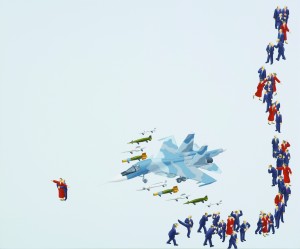 |
Metaphysical Art Gallery
7/F., No. 219,
Sec. 1, Dunhua S. Road,
Taipei City 106, Taiwan, R.O.C. map *
tel: +886 2 2711 0055
fax: +886 2 2731 7598
send email
website
|

Enlarge
|
| Where are you from?
|
|
| by Metaphysical Art Gallery
Location: Metaphysical Art Gallery
Artist(s): Nishizawa CHIHARU
Date: 8 May - 30 May 2010
Like the eye of God, Nishizawa Chiharu puts attention to the human world with tenderness and affectionateness-- living beings as ants and ecology as a mirror, nothing is invisible.
Nishizawa Chiharu is concerned with humankind and environment, explores life and social phenomenon, finely outlines different lives from the same and thereby pursues the ideal beautiful realm. The figures in his paintings can’t find clear faces all along but show the sharp body expressions though. No matter the vicissitudes of the universe or the nature at heart, they all paradoxically appear diverse postures and aspects in the likeness. The characters look like printed crowds but actually each of them is given unique personality through the artist’s elaborate drawing. They can be office worker in a trim suit, thrifty and modest housewives, diligent and optimistic labors or hypocrites in armor disguise. Against the simple happiness of the innocent children, Nishizawa Chiharu’s paintings express an implied life philosophy---full of wit and humor, sympathy but sanguinity.
Tell a story in the footsteps with no shadows; a long line of the crowd deduces lifetime episodes. Hope -stacking is proceeding under the painter’s graceful calmness, in emotion-veiled colors, no matter through the plots of pretense, adulation, power and profit scrambling or civilization creating. A story is evolved in the story and a scene is hidden in the scenery, which makes the painting more abundant to read, more complicated to explore. Just like appreciating a drama with great structure that leaves the audience infinitely imaginary space. And this is Nishizawa Chiharu’s peculiar spirit of “disharmonic” to tell a story--- men and women in fair outfits walking far from outside of the painting, with no strong strokes just like being attached on flatly, in subtle changes revealing a tense and dangerous atmosphere. There is a little unease strangeness existing in delicate familiarity, a hope shimmering under a frustrated worry and a cold crisis lurking within the triumphant pride. The audiences seem to fall into various scenes instantly, follow the troops’ footsteps, drive a lovely bombing plane in an airport mansion with a sea of people and then drift off the course together; to feel the slight blues and lost in the supermarket where provides everything; to reappear the civilization as “Along the River During the Qingming Festival” at a joyful celebration; to worship the fashionable art; to look into faraway romance under the mighty threat; to see politicians helplessly in exaggerative and immature masks on a ridiculous political arena; to gloat over misfortune when dressing in armor and climbing to the top glory through treading upon others’ corpses; to indulge in the happy billboard of hero worship, luxury, drugs and material needs; to satirize, desire, introspect; and to pursue a new dream world together.
The painting term of “bird’s eye perspective” derives from Japanese style “Yamato-e”. However, the panorama in the heart of Nishizawa Chiharu is the universal scenes of human beings. For the first solo show in Metaphysical Art Gallery, Taipei, the artist integrates Taiwanese old city gate, General Wa, octagonal pavilion, Sinyi District and depicts people in different environments, yet having similar direction and aspiration. In the painting of “Exodus-d”, the folks are celebrating this evergreen Formosa with songs and dances, the graceful team circling an extent of imaginary blank space. Next to the merriness, the roads are undergoing renovation and beyond the enclosure the envious are racking their brains but still can’t leap over the strong guard of General Wa. In “ Exodus-a”, the grand buildings in Sinyi district are similar to the undulate chain of mountains. People who live on the top of this city look like barefoot warriors—taking off the military boots, obeying the command tamely of those girl scouts, lining the rank of the migratory birds. And there is a little girl scout aside in no boots moving out quietly. With regard to “Sandbox-holic”, the sand castle mounded with a pious ritual appears to be a mirage; the happy game of children’s theater is like sand that vanishes easily. Since life in a sandglass is taken to be a virtual wish, it’d rather remain the real toys after the game comes to the end.
Where are you from? And where are you going? “So much information flies about in our ordinary life, something we can’t find a reality between our world and ourselves.” Through children’s games which are simple but never being boring to them, Nishizawa Chiharu discovers that the pure happiness as the necessary blank space of the painting will make the work more generous. Like “Swing-holic”, we can feel strongly that the painter in deep sincerity cultivates simple pleasure inside the painting. We seem to hear children’s joyful laughter among the regular sway of the swing, compared with adults’ alienated and punctilious normality, yet the same regularity presents different passion. Where are the people going, which is just Nishizawa Chiharu’s anxiety and expectation for concerning this boundless universe. His pursuit from the heart for a pretty pure world -- only the grinning dinosaur knows. |
|
|
|
|
